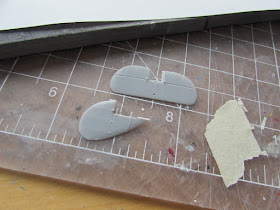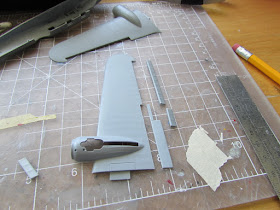https://wingsofintent.blogspot.com/2019/08/short-s4-satellite-avis-172nd.html
I am elated by the release by Avis of a plethora of charming and good-looking civil planes in 1/72, a welcome break from the usual gloom and doom, with less common and sometimes colorful types, and all this at affordable prices with a reasonable level of detail.
I am acquiring their releases to support their choices, eager as I am for not really common
civil kits, having been many times forced to resort to conversions of existing
kits, or scratch-building, to satisfy my preferences for graceful, well-meant,
significant and why not many times cute and adorable little flying things.
All the late Avis releases are short run, meaning that you
have to put a little of yourself there, you know, that thing, modeling.
The Short Satellite belongs to the Light Plane category, the same league for which I scratched ther De Havilland D.H.53 and the Parnall Pixie:
A good reference for these types is The Lympne Trials, by Ord-Hume.
I have had a file on Satellite for many years. In comparing the kit to my files I found it to be quite spot on, even having in the sprues the two engines (Cherub and Scorpion) that the plane had (The plane attended the Lympne light plane competition in 1924 and 1925 with a Cherub, and the 1926 one with a Scorpion).
The kit provides a closing part for the aft cockpit for the version with the registration (as depicted in box art), but it also flew with that registration with the aft post uncovered. Parts are provided of course for both positions.
There is a very small omission on the decal sheet: the scheme with the number 8 should have also two number 8 under each wing, with a white outline:
http://www.shu-aero.com/AeroPhotos_Shu_Aero/Aircraft_N/Short/Short_Satelite_S_4_G_EBJU_01_large.jpg
http://www.shu-aero.com/AeroPhotos_Shu_Aero/Aircraft_N/Short/Short_Satelite_S_4_G_EBJU_01_large.jpg
There as an additional scheme with the number 15 too.
Good instructions:
The level ,of detail you would expect for this type of kit:
Surface detail:
The instructions are missing a diagonal third tailplane strut:
All parts separated and cleaned up in a matter of a half hour:Some internal fuselage detail:
The wing roots had a thicker airfoil, so Avis solved this issue with a separate half part to avoid shrinkage and sink holes and preserving the thinness of the rest of the wing, that would have been otherwise affected by a lower and upper part arrangement:
Again, careful cleanup and dry-fitting, and then glued with no trouble, but the seam (which runs on a rib) will need tidying:
The interior is being prepared:
Painting of the interior and other parts begins:
The fin has spigots that pass through holes in the stab. I needed to enlarge those just a bit for a comfortable fit:
The nose of the fin should touch the fuselage spine, but as it is leaves a small gap, so a small piece of styrene is glued in place to be later re-contoured:
The interior is in place:
The fragile tailskid may not last, so better replace it with some wire later:The seam is masked and puttied:
And that's that:
Fuselage halves united:
Just for the giggles, fuselages of Anson and Short Satellite compared:
First coat of primer to reveal blemishes:
After treating some blemishes, the wings are glued, and the tail unit is assembled:
The tailskid was replaced with a drill bit shaft. The compression legs for the landing gear are too long. I ended up drilling their location on the fuselage and shortening the other end a bit for a comfortable fit:
Gloss black base:
As the build approach the final stages, I have to make a decision on which type of engine I will use, Cherub or Scorpion. The kit as said at the beginning provides both, if in a rather simplified rendering.
Here are the options on the instructions:
The other side:
I think the more "complicated" cylinder (Bristol Cherub) head position is not correctly depicted on the instructions, and should be sideways, with the exhaust at the front sticking downwards.
Now, compared to photos of the real engines, none of the parts look particularly faithful.
I have many photos of those engines, but none of the photos I have of the Satellite shows, to the fullest extent and with pristine clarity the actual arrangement of those cylinders, which tended to vary quite a bit depending on installation, model, etc.
I will go for the "sideways" -contradicting the instructions- installation of the Cherub, because it's closer to reality and resembles better what I can see in photos of the Satellite, a somewhat flat cake against the surface of the cowl.
It also seems that the exhausts were rotated from going to the sides to going down.
Decisions, decisions...
All flying surfaces (fabric-covered) are painted white aluminium:
A note regarding changes in time of this plane:
As we know photos show three different schemes
a) Number 8 (that photos clearly show under the wings too outlined in white, missed by the kit's decal sheet)
-This scheme can be seen with and without the louvers on the nose.
b) Civil registration (G-EBJU) and G on rudder.
c) Number 15 and the Seven Feathers Aero Club logo on the nose. G on rudder, regs on wing only, Seven Feathers logo on the nose.
The prop is seen in some photos painted in metal color, or on wood color with small metal spinner tip.
The aft position is seen covered and uncovered, and with or without windscreen.
-All the tail control cables were added, as well as the three struts for the stab (that you have to make yourself). The cables that go to the upper elevator control horn pass trough the stab and emerge on the other side
-The decals are by Decograph in Ukraine. Sharply printed, thin, easy to apply (i.e. no fold-overs if applied carefully), will admit playing a bit to find right position.
I trimmed each individual large reg. letter for the wings:
The Pitot is added. Photos show an alternate position for it, quite unorthodox: the right leg of the landing gear. The Cherub heads can be seen on the ground:
I finally decided to tackle the fuzzy render of the engines choosing the Cherub head provided and adding just a few stacked cylinder fins to it so it can fit comfortably in the recess provided:
The windshields are next. Four are provided, which is great, because I lost two in the first three minutes of trying to cut them and positioning them:
Prop, engine and windshields on:
To be continued.....





















































































































